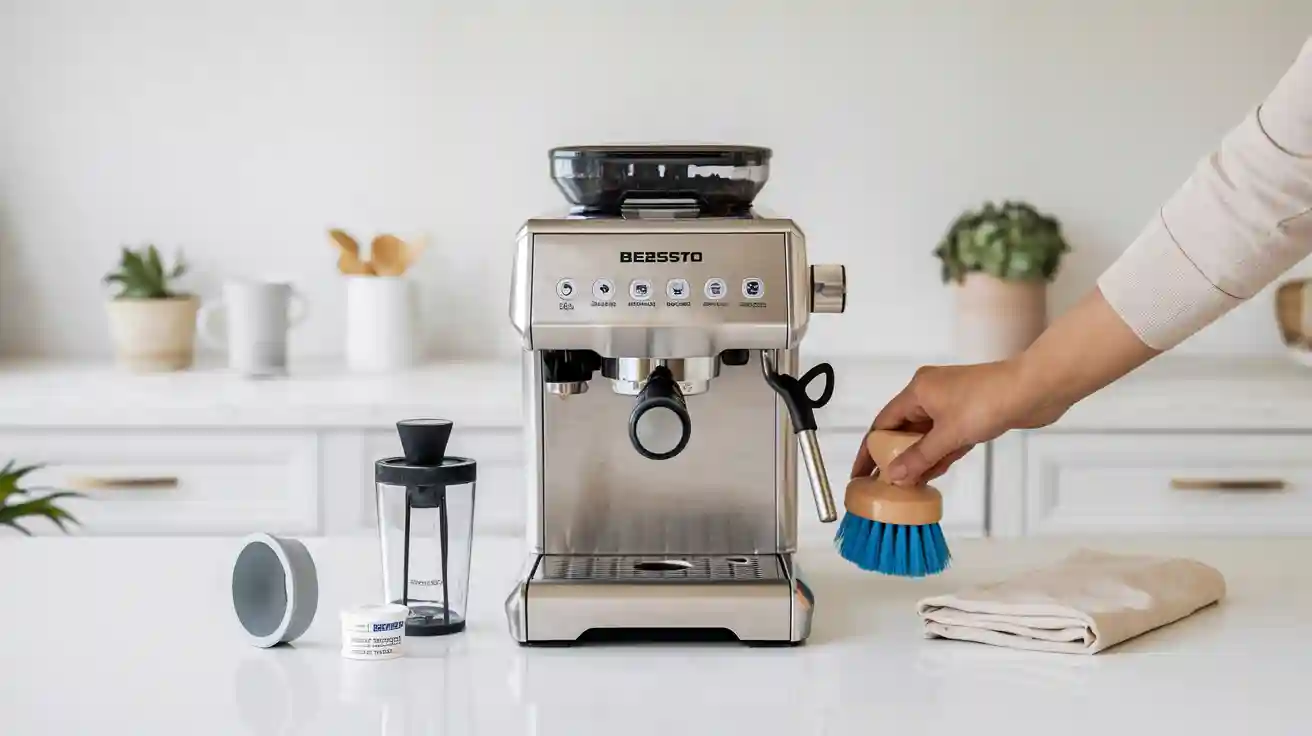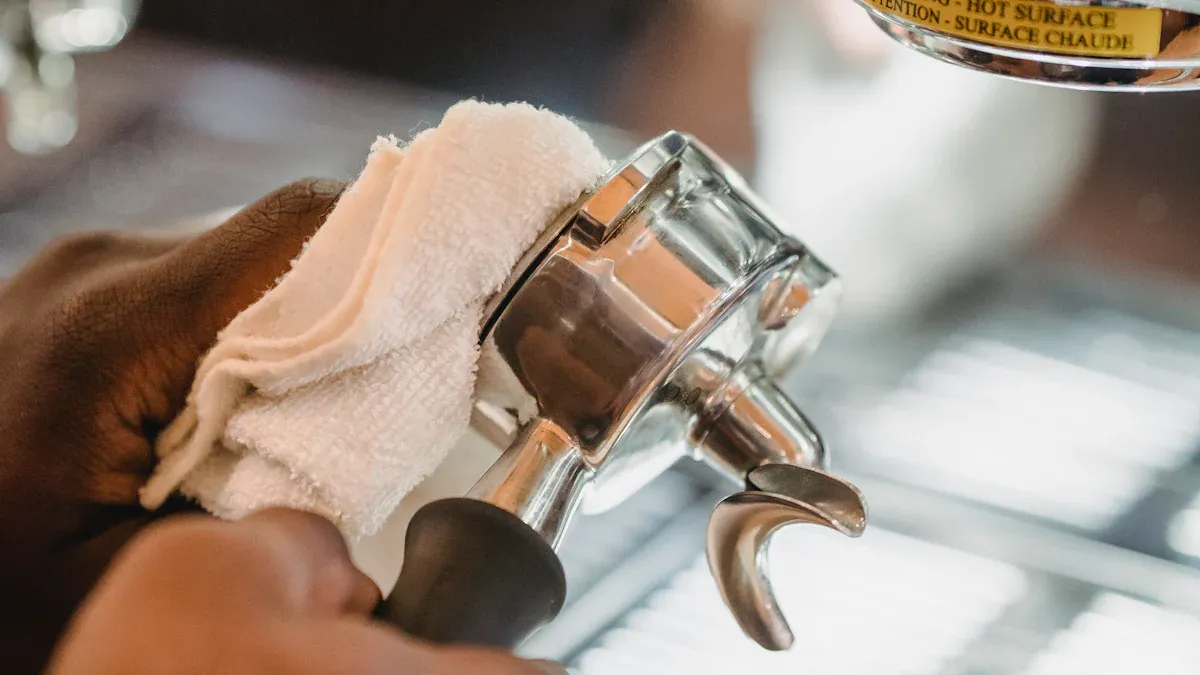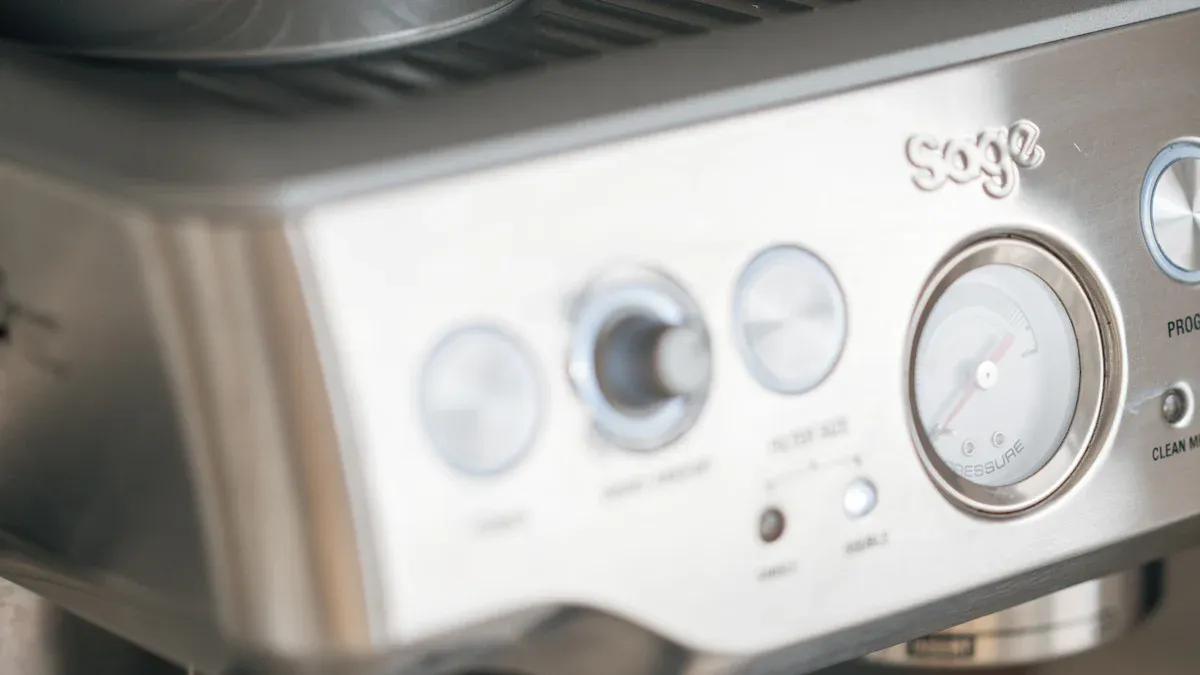
You want your bes870 barista express espresso machine to last. Regular cleaning keeps your machine working smoothly. Simple routines help you prevent blockages and enjoy rich espresso every time. The breville barista express gives you great coffee, but only if you care for the espresso machine daily.
Simple Maintenance Steps for Your Espresso Machine
Daily Espresso Machine Care
You keep your espresso tasting great by following a simple daily routine. Start by wiping down the exterior of your BES870 Barista Express Espresso Machine with a damp cloth. Remove the portafilter and rinse it under warm water. This step prevents old coffee grounds from building up and affecting the flavor of your next shot.
After each use, purge the steam wand by turning it on for a few seconds. This clears out milk residue and keeps the wand clean. Empty the drip tray and rinse it to avoid unpleasant smells. Fill the water tank with fresh water every morning. These steps take only a few minutes but make a big difference in the taste and quality of your espresso.
Tip: Always use filtered water in your machine. This reduces mineral buildup and helps your espresso machine last longer.
Weekly Cleaning Routine
A weekly cleaning routine helps your machine run smoothly and saves you money. You should backflush your Breville Barista Express with a cleaning tablet or powder. This process cleans the internal valves and removes coffee oils that can cause blockages. Take out the drip tray and water tank for a thorough wash with warm, soapy water. Clean the steam wand tip with a pin to remove any milk residue.
Here is a table showing the benefits of regular weekly maintenance:
| Benefit Category | Without Regular Maintenance | With Regular Maintenance | Quantified Improvement / Savings |
|---|---|---|---|
| Coffee Waste | 8-12% beans wasted on rejected shots | 3-5% wastage rate | 7.3% reduction in coffee usage; 8% reduction in waste |
| Repair Costs | $800-1,200 annually per group | $200-400 preventive service | $600-800 savings annually per group |
| Component Replacement | Every 3-4 months | Every 6-12 months | $150-300 savings annually per group |
| Machine Lifespan | 5-7 years before major rebuild | 8-12 years optimal performance | Extended lifespan by 3-5 years |
| Service Calls | Higher frequency | 23% reduction | Fewer service calls after maintenance standardization |
Weekly cleaning keeps your espresso tasting fresh and your machine working at its best. You also save money by reducing waste and repair costs.
Monthly Deep Cleaning
Once a month, give your espresso machine a deep clean. Remove and soak the portafilter, baskets, and drip tray in warm, soapy water. Use a brush to clean the group head and remove any stubborn coffee residue. Run a descaling solution through the machine to break down mineral deposits inside the pipes and boiler.
A study in the Journal of Coffee Research found that espresso machines cleaned monthly keep 95% of their original performance after three years. Machines cleaned less often drop to only 68%. Regular deep cleaning prevents 80% of common problems and helps your machine last up to 40% longer.
Note: Monthly deep cleaning is the most important step for long-term performance. It prevents buildup that can cause serious breakdowns and keeps your espresso tasting rich and smooth.
By following these simple steps, you protect your investment and enjoy delicious coffee every day. Regular maintenance helps you avoid costly repairs and keeps your BES870 Barista Express Espresso Machine running like new.
Cleaning Key BES870 Barista Express Espresso Machine Components

Group Head Cleaning
You keep your coffee tasting fresh by cleaning the group head every day. This part of the BES870 Barista Express Espresso Machine touches every shot you brew. When you clean it, you remove oils and grounds that can spoil the flavor. Use a group head brush and backflush disc for best results.
- Regular cleaning prevents buildup of coffee oils, grounds, and mineral residues that negatively impact flavor, consistency, and extraction.
- A clean group head ensures consistent pressure and water flow, essential for proper extraction and a well-balanced espresso.
- Daily cleaning routines such as purging, backflushing, and brushing remove residues that cause bitterness and off-flavors.
- Neglecting cleaning leads to blockages and corrosion, degrading machine performance and coffee quality.
- Proper cleaning extends machine longevity and maintains optimal espresso taste, texture, and aroma.
- Using specialized tools (group head brushes, backflush discs) and cleaning solutions enhances cleaning effectiveness.
- Infrequent cleaning risks hygiene issues and potential contamination, further supporting the need for regular maintenance.
Steam Wand Maintenance
You get smooth, creamy milk for your coffee when you care for the steam wand. Maintenance records show that purging the wand before and after each use, wiping it daily, and soaking the tip in a cleaning solution stop milk from clogging the wand. These steps help you froth milk better and keep the wand working well.
Drip Tray and Water Tank Care
You should empty the drip tray every day. Rinse it with warm water to stop odors. Clean the water tank weekly with mild soap. Always refill with fresh water. This keeps your machine running smoothly and your coffee tasting pure.
Grinder and Hopper Cleaning
You keep your grinder and hopper clean by brushing out old grounds each week. Remove the hopper and wash it with soapy water. Dry it fully before putting it back. This prevents stale coffee from mixing with fresh beans and helps your machine grind evenly. Remember to descale your machine monthly to protect all parts from mineral buildup.
Preventing Espresso Machine Issues
Avoiding Blockages in the BES870
You can prevent blockages in your BES870 by following a few simple habits. Always purge the group head right after you pull a shot. This step clears out coffee grounds and keeps the water path open. If you skip this, you might notice uneven pressure or weak espresso. Wipe and purge the steam wand before and after every use. This stops milk from drying inside and blocking the wand. When the “clean me” light comes on, run a backflush cycle. This keeps the inside of your machine clean and helps maintain steady pressure. Change the water filter every two to three months. This keeps the water pure and helps your machine last longer.
Tip: If you see “no water” on the display, check the tank and refill it with fresh, filtered water. This prevents air from entering the system and keeps the pressure stable.
Managing Scale Build-Up
Scale can cause many problems in your espresso machine. Hard water leaves mineral deposits inside, which can block pipes and lower pressure. You should descale your machine once a month or follow the descaling routine in your manual. Use filtered or softened water to slow down scale build-up. If you see “no water” warnings often, scale might be blocking the flow. Regular descaling keeps your machine running smoothly and protects the boiler. This step also helps you avoid expensive repairs.
Note: Using filtered water is the best way to prevent scale, which is the main cause of machine failure.
Keeping the Grinder Running Smoothly
A clean grinder gives you even grounds and better espresso. You should brush out old coffee from the grinder and hopper every week. Take apart the grinder blades and clean them every two weeks. This stops oil and dust from building up and keeps the motor cool. Regular cleaning also keeps the pressure steady during extraction. If you keep up with this routine, you will spend less time cleaning and more time making coffee. You also avoid problems like dull blades or overheating.
- Clean blades and vents to reduce cleaning time by 30%.
- Regular checks help prevent downtime and keep your machine reliable.
- Good grinder care means better pressure and a longer-lasting machine.
Troubleshooting Common BES870 Barista Express Espresso Machine Problems
Low Pressure or Weak Espresso
You may notice your espresso comes out weak or the pressure gauge on your BES870 Barista Express Espresso Machine does not move as expected. This problem often means something blocks the water flow or the machine cannot build enough pressure. Sometimes, you see no espresso at all, or the pressure gauge stays low even when the pump works.
A common cause is scale buildup inside the solenoid valve. When this valve gets clogged, water cannot pass through at the right speed. You might try backflushing, but if the solenoid valve has too much scale, this step will not fix the issue. Cleaning and descaling the solenoid valve usually restores most of the normal pressure. After cleaning, you may see the pressure gauge reach about three-quarters of the normal range. The espresso will taste better, but you may still notice a small difference in flavor if the pressure does not reach the full range.
If you see “no water” on the display, check the tank first. Refill it with fresh water to avoid air in the system. If you still have no pressure, focus on cleaning the solenoid valve and running a descaling cycle.
Steam Wand Troubleshooting
If your steam wand does not produce steam or only gives a weak flow, you can fix this with a few steps. First, always purge the wand before and after each use. This step clears milk from the tip and keeps the holes open. If you notice no steam or a drop in steam power, soak the tip in warm water and use a cleaning pin to remove any milk residue.
Sometimes, the “no water” warning appears when you try to steam milk. This alert means the tank is empty or not seated correctly. Make sure the water tank is full and locked in place. If the wand still does not work, run a cleaning cycle to clear any blockages inside the steam system.
Tip: Regular cleaning of the steam wand prevents milk from drying inside and causing blockages. This habit keeps your machine ready for smooth, creamy milk every time.
Grinder Troubleshooting
You may run into problems with your grinder, such as uneven grounds, no grinding, or a jammed hopper. Diagnosing these issues starts with checking for oily beans or old coffee stuck in the grinder. Oily beans leave sticky residue that can clog the burrs and chute. Clean the grinder and hopper every week to prevent this.
Industry experts and manufacturer guidelines recommend brushing out the chute and wiping the burrs with a damp cloth. Always dry the burrs before putting them back. Never use rice or water to clean the grinder, as this can damage the parts. Specialty cleaning tablets help keep the grinder running smoothly. If you hear strange noises or the grinder stops, check for foreign objects or worn parts. Replace gaskets and seals as needed.
Regular cleaning and following the machine manual help you avoid most grinder problems. Schedule professional servicing if you notice ongoing issues or need a deeper repair.
Fixing Leaks and Drips
Leaks and drips can happen if seals wear out or parts become loose. If you see water under your machine or around the drip tray, check the tray and water tank for cracks or misalignment. Make sure the tank sits flat and the seals are clean. Tighten any loose screws or fittings you find.
If you notice water leaking during brewing, inspect the group head gasket. Replace it if it looks worn or cracked. Sometimes, leaks come from scale buildup inside the pipes. Running a descaling cycle can clear these blockages and stop leaks. Always use filtered water to reduce mineral deposits and keep your machine in good shape.
A quick check of seals, gaskets, and the water tank can solve most leaks. Regular maintenance keeps your machine dry and working well.
Quick Espresso Machine Maintenance Checklist

You can keep your BES870 Barista Express in top condition by following this easy checklist. Use it as a quick guide for daily, weekly, and monthly care. Regular attention helps your machine deliver great espresso every time.
Daily Tasks
- Wipe the exterior with a damp cloth.
- Rinse the portafilter and basket under warm water.
- Purge the steam wand before and after each use.
- Empty and rinse the drip tray.
- Fill the water tank with fresh, filtered water.
Weekly Tasks
- Backflush the machine using a cleaning tablet.
- Wash the drip tray and water tank with mild soap.
- Clean the steam wand tip with a pin.
- Brush out the grinder and hopper.
Monthly Tasks
- Deep clean the group head with a brush.
- Soak the portafilter, baskets, and drip tray in soapy water.
- Run a descaling solution through the machine.
- Take apart and clean the grinder blades.
Tip: Set reminders on your phone for weekly and monthly tasks. This habit helps you stay on track and keeps your machine running smoothly.
| Task Frequency | Main Actions |
|---|---|
| Daily | Wipe, rinse, purge, empty, refill |
| Weekly | Backflush, wash, clean, brush |
| Monthly | Deep clean, soak, descale, disassemble |
You protect your investment and enjoy better coffee when you follow this checklist. Consistent care prevents most problems and extends the life of your machine.
Consistent care keeps your BES870 Barista Express espresso machine running strong. You avoid big problems when you follow these steps. Use the checklist for quick reminders. Your machine will make better espresso every day. Take pride in your clean machine and enjoy every cup.
FAQ
How often should you descale your BES870 Barista Express?
You should descale your machine every month. If you use hard water, descale more often. This keeps your espresso tasting fresh and your machine running well.
What should you do if the “Clean Me” light stays on?
First, run a cleaning cycle with a cleaning tablet. If the light stays on, check the manual for troubleshooting steps or reset the machine.
Can you use vinegar to clean your espresso machine?
You should not use vinegar. Vinegar can damage the internal parts. Always use a descaling solution made for espresso machines.


